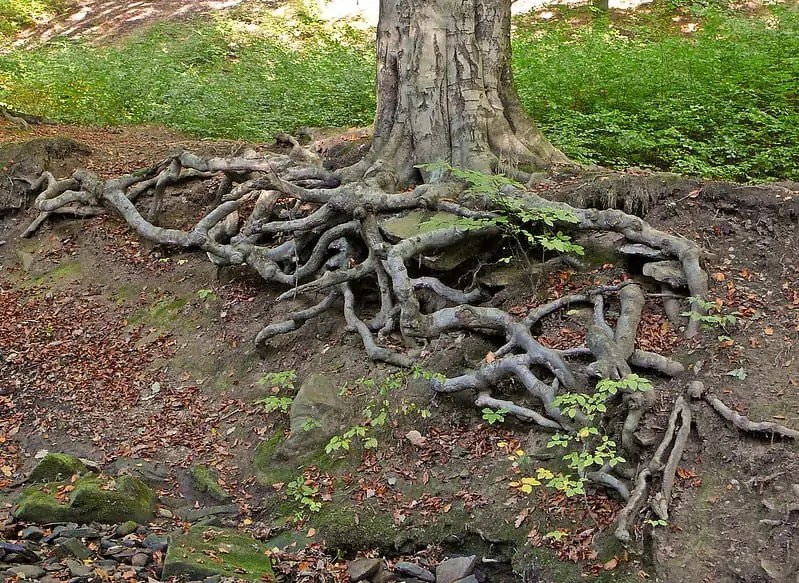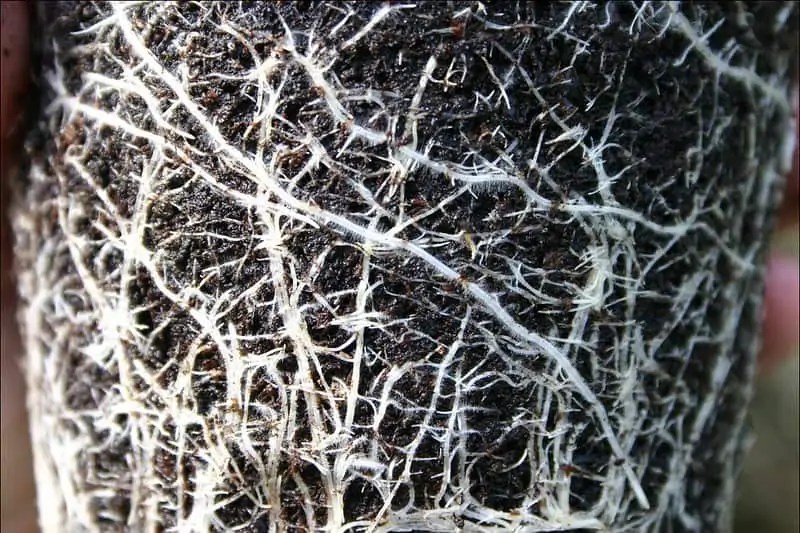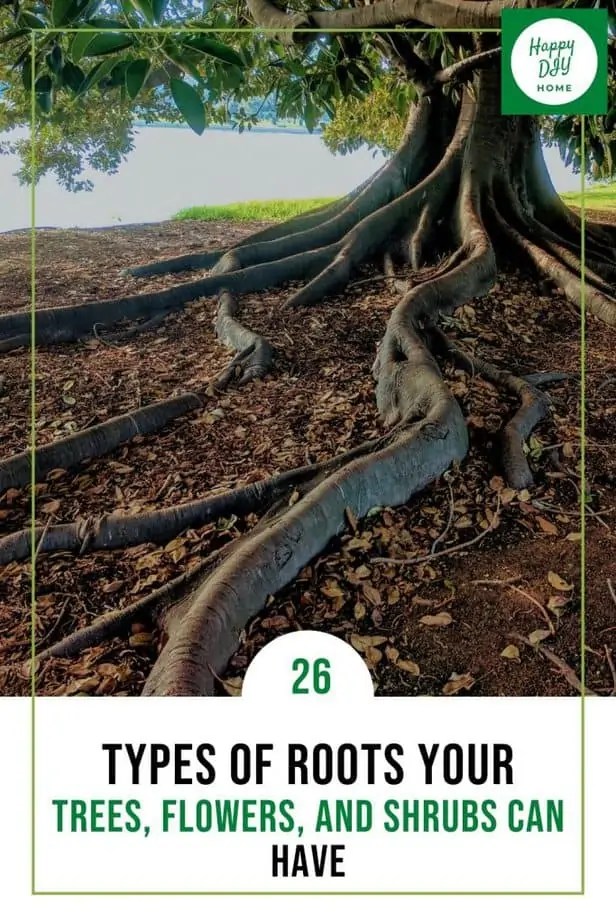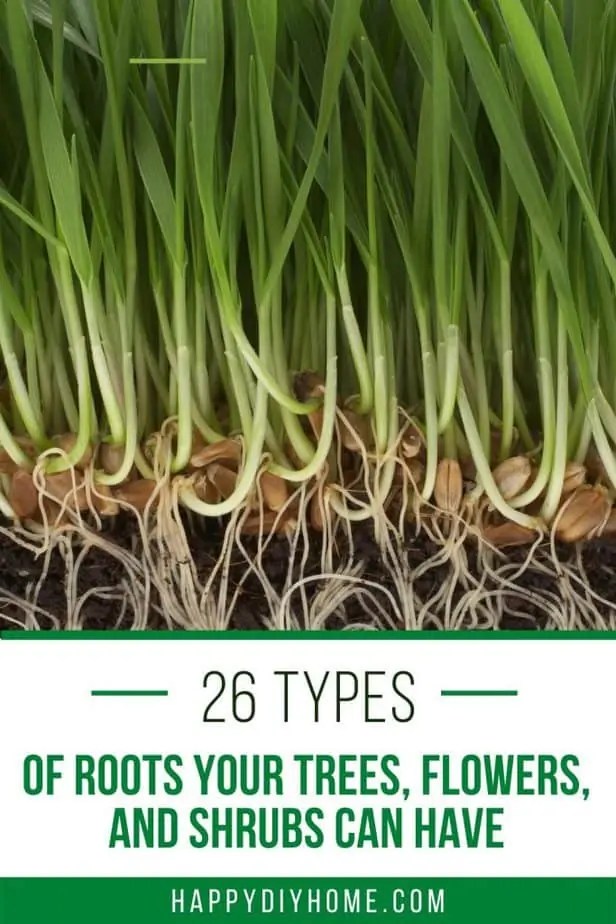The root system is the non-leafy part of your plant’s body that doesn’t have any nodes. It’s the part of your plant that is below the surface of the soil, unless they’re aerial roots. Aerial roots are types of roots that grow above the ground or are aerated and float over the surface of the water like many ivy plants do. The different types of roots are responsible for providing the leaves and stems of the plants with nutrients and water so they can grow, and we’re going to break down several types of roots for you below to ensure that you get a good understanding of this necessary system.

Plant roots can grow above or in the ground, and these systems serve to feed and nourish the plant as it grows. Roots by Tim Green / CC BY 2.0
Contents
How Root Systems Develop
In most instances the root system on your plant starts in the embryo inside the seed. This is called the radicle, and it’ll eventually grow and turn into the primary type of root your plant uses to get water and nutrients. It can evolve into one of two main types of roots, including a fibrous or taproot system.
- Fibrous Roots– When a plant has this type of root, the radicle dies and it gets replaced by the adventitious roots. The roots grow from the same cells that the plant stem does, and they’re usually much finer than tap roots. You’ll see a very dense mat of roots below the plant. Grass is one example of this type of root system. Another good example would be sweet potatoes with their fibrous roots. They use the roots to store carbohydrates.
- Taproot– In this type of root system, the primary root keeps growing into one larger trunk. It has several smaller branches that emerge from the sides. The plant can modify a taproot system to work for carbohydrate storage, like beets and carrots do, or it can grow deep into the ground to find water, like poison ivy and mesquite plants do.
1. Adventitious Roots
This type of root is very similar to fibrous roots. However, they can be aerial or underground, and they can easily grow from any part of the plant except from the radical. They usually grow from the stem nodes, intermodal, and leaves. The roots can also be thin, thick, or modified, according to the plant species.
These roots appear under stress conditions like waterlogging after the area floods. Branch and leaf cuttings in plants like roses can cause these roots to develop. They can also develop if the plant gets injured. This can increase the chances of the plant’s survival because the plant uses these roots to propagate.
2. Buttress Roots
You can see a great example of this type of root on the taller kapok tree. This tree has wide and thin roots that extend vertically from the trunk’s base to make them very noticeable. You’ll typically find these roots in areas of shallow, nutrient-poor soil. They work to help stabilize the buttress of the tree by widening the foundation to ensure that it stays in position.
3. Creeping Roots
Creeping roots are a type of root that won’t penetrate deep down into the soil. Instead, they’re very shallow, and they spread a long way horizontally from the base of the plant. A lot of trees come with this root system.
4. Dicot Roots
Dicot roots are types of roots with several lateral shoots on them that extend out. They’re an offshoot of the main root system, and this is where a lot of secondary growth occurs as the plant matures and ages.
5. Fibrous Roots
You’ll find fibrous roots in monocot plants, like grasses. They’re branched, slender, and they grow right from the stem. They also tend to grow very close to the surface and spread out horizontally instead of vertically. You’ll see a cluster-like appearance with this root, and several roots grow together to reach nearly the same size. In this root system, the primary root is very short-lived.
Instead, it dies off and gets replaced by a thicker mat of shorter and smaller roots. Since these roots are closer to the surface, they usually don’t provide decent anchorage to the plant because they don’t go down deep into the soil. They typically grow from the base of the stem.

When most people think of fibrous roots, grass comes to mind. These roots are slightly more fragile and shorter than other types. Grass by Kamil Porembinski / CC BY-SA 2.0
6. Foliar Roots
Foliar roots come naturally from the petioles or leaf veins due to an injury to the plant’s leaf. The injured region will slowly develop new buds that are called foliar buds. Eventually, this will give way to a new type of root that encourages a whole new plant to grow. Sometimes, you can apply a plant growth hormone to stimulate the cutting or injured part of the plant and encourage it to grow new foliar buds wherever you apply it. This is a popular application for the rubber plant, Begonias, Bryophyllum, and Pogostemon to get more plants from the mother plant.
7. Monocot Roots
On this type of root during the development process, the pericycle develops lateral roots only. The pith on the root is very large and well-developed, and they have several phloem and xylem. There is no secondary growth present.
8. Parasite Roots
As the name suggests, these types of roots are ones that attach themselves to another plant and pull nutrients from it, just like any parasite does. They won’t offer any benefit to the host plant. Instead, these roots work to cause serious damage, and they can even kill the host plant eventually. A few examples of plants with these types of roots include Dwarf mistletoe, dodder, Rafflesia, Corpse Flower, and the Hydnoraceae.
9. Prop Roots
In addition to having ordinary roots, some plants come with a specialized root system that helps to ensure that the stem stays in an upright position. These are prop roots, and the corn plant is an example of one plant that has them. The roots grow from the lower part of the tem and help to prop up the taller plant. They’re very valuable to any slender and taller plant that have more shallow root systems to ensure that they don’t fall down or bend over under their own weight.
10. Taproots
You’ll find taproots in the large majority of dicot plants. This type of root features a direct elongation of the plant’s radical. Unlike what you’d see with fibrous roots, these roots don’t have branches. Instead, you get a single primary root system that grows very deep into the soil. The taproot has lateral branches called tertiary and secondary roots that help form the taproot system. The branches of this root grows in acropetal succession, and this means that the older and longer ones are situated at the base and the shorter and newer roots are at the apex of the primary root.
You’ll get very strong anchorage with this type of root. Since they penetrate very deeply into the soil, you get a very strong support system. In some plants, this root may not go as deep. Instead, it has lateral branches that grow horizontally along the soil’s surface, and this is called a feeder root system. The primary root will survive as long as the plant does though.
11. True Adventitious Roots
Any lateral bud that comes from the plant stems at the internodes and node level are classified as true adventitious types of roots. Even though every plant root gets classified into two types based on the overall structure, some roots have more modifications to them to help them carry out specific functions. A few examples would be the aerial roots of the Banyan tree, clasping roots of the money plant, and the stilt roots of the sugarcane plant.
12. Tuberous Roots
This is a very thick type of root, and it can work to store more significant amounts of food for the plant, and it’ll feed the entire plant. They’re enlarged, fleshy, and work as a modified storage organ for the plant. The propagation process of this type of root uses crown division where each crown comes with several buds and a lot of storage to create a new plant. Orchids, roses, daylilies, and dahlias are all examples of plants that have this root system.

A lot of people picture potatoes when they think of tuberous roots, but these types of roots also apply to flowers like daylilies and orchids. Daylilies by Renee Grayson / CC BY 2.0
13. Water Roots
As the name suggests, this type of root is for plants that grow in water. They’re more brittle and much finer than other root types. They also offer the capability of allowing oxygen from the air to diffuse. In turn the roots use them for growth and metabolism. They’re also morphologically different from traditional soil-based roots.
8 Types of Roots Based on Physiological Functions
Sometimes, roots get modified to perform the basic physical and chemical processes the plant needs to grow and survive. When they do, you can end up with the following types of root systems:
- Aerial Roots – Better known as epiphytic roots, you can find them above the ground. They help the plant absorb moisture that is in the air, and a few examples are Banyan trees, mangroves, poison ivy, and common ivy.
- Assimilatory Roots – This type of root is also referred to as photosynthetic roots, and they’re the green roots that use photosynthesis to make food for the plants. Plants with this root system include Tinospora, Trapa, and Taeniophyllum.
- Epiphytic Roots – These roots grow on the branches and trunks of trees, and they’re also called hygroscopic roots. They help the plants absorb moisture using the velamen, and this is a sponge-like tissue. They’re the main root systems of epiphytic plants, including Dendrobium and Vanda.
- Parasitic Roots – We touched on these roots above, and people also call them haustorial roots. Viscum and Cascuta are two examples, and they depend 100% on the host plant to survive.
- Reproductive Roots – These are fleshy, soft adventitious roots that develop buds that can grow into new plants. You’ll have this type of root with dahlias and sweet potatoes.
- Respiratory Roots – Also called breathing roots or pneumatophores, you’ll find these roots above ground. They help the plants by doing a gas exchange, and a few examples of plants that use this root system are Ceriops, Avicennia, Heritiera, Sonneratia, and the Mangrove plant.
- Saprophytic Roots – These roots help with mineral and water absorption, and they’re also called mycorrhizal roots. Fungal hyphae use these roots, as do Sarcodes and Monotropa.
- Storage Roots – These roots become very fleshy to help store reserves of minerals and food for the plant, and you’ll find them on Echinocystis, Mirabilis, beets, carrots, and radish plants.
5 Types of Roots Based on Mechanical Functions
Some roots develop modifications to help protect and strengthen the plant. The following five types of roots are excellent examples of this phenomenon, and they include:
- Climbing Roots – These are adventitious aerial roots that start from the internodes or nodes of more weak-stemmed plants to help support them as they climb. Piper betel, Pothos, Hedera, and Vanilla are all examples of plants with these roots.
- Contractile Roots – Better known as pull roots, they are an underground, modified stem that will adjust itself to swell or contract according to the mineral and water absorption rate and the soil depth. Lilum, Allium, Canna, Freesia, and Crocus are all plants with this root system.
- Floating Roots – These roots develop from floating plants’ nodes, and they help the plant float in the water. Duckweed and Water lilies are two plants that feature this type of root system.
- Root Thorns – This is an adventitious root that can get very pointed and hard to help reduce how much water the plant absorbs to help the plant adapt and survive in a low-water environment. Iriartea, Acanthorhiza, and Pothos are three plants that you’ll find in semi-arid and arid regions with these roots.
- Stilt Roots – These are obliquely growing roots in the adventitious category that develop on the lower nodes on the plant’s stem to help give the plant more support. Maize, sugarcane, Pandanus, sorghum, and Rhizophora all have them.
Basic Root Anatomy

There are four main regions of the root, and they include the elongation region, maturation region or root hair zone, meristematic region, and the root cap. We’re going to break each region down below so you can get a better understanding of types of roots and how they develop. Roots by Barney Livingston / CC BY-SA 2.0
Part One – Elongation Region
Just above the region of the root where cell division happens, you’ll find the cell elongation region. This is where the cells grow into the normal size root cells. As the younger cells start to grow, the plant will form more cells at the root tip. The cells in this region will increase in volume much faster than the amount of cytoplasm inside increases. Because of this, the plant will form more and more vacuoles. Eventually, the smaller vacuoles will fuse to help create a bigger central vacuole that will fill with water from the surrounding soil. This will increase the root length, and this results in:
- The number of cells in the cell division region will increase
- You’ll see new cell elongation in the cell elongation region
When you put these two regions together, they’re very short. They come in at right around two millimeters.
Part Two – Maturation Region (Root Hair Zone)
Just above the cell elongation region is a region where the plant cells mature. They become specialized and differentiate to be able to take on specific tasks. For example, some cells will turn into cortex or cortical cells while others turn into phloem cells. The epidermal cells are the parts of the root that develop root hairs at the farthest part of the cell elongation region. They develop fully when the epidermal cells get to their maximum length and start to differentiate. So, this region is also called the root hair zone. The older root hairs will start to die at the furthest end of this root region. New hairs will form as quickly as the older ones die.
Part Three – Meristematic Region
Meristematic literally means rapid growth, and you’ll find this region just above the root cap on different types of roots. The cells grow very quickly, and they’re very thin-walled and small. Also, they have very dense protoplasm.
Part Four – Root Cap
The root cap is located at the root’s apex, and it forms a thimble-like structure. The root’s apex is very tender, and the root cap functions to protect the tender root end. It also helps with deeper root propagation. It secretes a mucus that helps to lubricate the root’s passage through the soil. It will eventually wear out, but the root system renews it constantly.
Eight Important Root Functions
In terms of function and bulk, the types of roots form up a large portion of the plant. They have several major functions, including:
Absorption and Conduction
Roots form root hairs, and the roots use these hairs to absorb nutrients and water from the soil, and this is essential for plant growth. Different types of roots can also absorb inorganic nutrients when it’s against the concentration gradient. Once the plant absorbs all of the nutrients and water, they move them upwards to the plant’s leaves and stems.
In the desert, roots will grow much deeper to reach the permanent water reserves. Areas in the desert where you can find plants are widely thought to have hidden water reserves deep underground. This helps you know where to dig a well if you need to.
Aeration
Any plants that grow on the surface of stagnant water develop specialized types of roots that are called pneumatophores. These roots work to diffuse oxygen from the air.
Anchor and Support
This plant’s root system helps to provide physical support by anchoring the plant’s body directly to the soil to keep it in an upright position. A lot of plants can easily stand upright for hundreds of years because they have roots that grow deep into the soil and achor the plants in place.
Movement
A lot of bulb-forming plants have contractile roots that will pull the plant downwards and directly into the soil. The environment underneath the soil is more favorable for these types of plants.
Photosynthesis
Photosynthesis is the process where plants take the nutrients and water to prepare food using the sun. Some roots can perform photosynthesis, including the aerial roots that mangrove plants have and epiphytic orchids.

Photosynthesis is the process that keeps your plants alive, growing, and healthy. A good root system is key to this process. Photosynthesis by Omar Villanueva / CC BY-NC-ND 2.0
Reproduction
Some specialized types of roots work for reproduction. They will help to further the plant species. In certain plant types like the agoho when it reaches maturity, you’ll see offshoots growing around the trunk from the horizontally-growing root system.
Storage
Some roots like sweet potatoes and carrots have roots that work to store nutrients. They will store both water and carbohydrates. If you look at roots on desert plants, they can easily store up to 70 kilograms of water.
Transport
Most roots come with specially designed channels that transport any absorbed water and nutrients to the plant’s leaves and stem. Also, they have channels that they can transport organic food particles from the aerial parts of the plants down to the root system.
Medicines that Come from Different Types of Roots
Did you know that different types of roots are very important components in some medicines? Although there are hundreds of roots with medicinal uses, we’re going to outline the more well-known ones below for you.
Ashwagandha
This is an evergreen shrub that you’ll find growing in Africa and Asia, and it’s a very common plant for helping manage stress. A lot of people use it as an adaptogen, but there isn’t a lot of evidence to support this use. This plant contains chemicals that can help calm your brain, lower your blood pressure levels, reduce swelling, and help to alter your immune system.
Since this root is traditionally used as an adaptogen, you’ll find people using it for dozens of reasons tied back to stress. Adaptogens are widely believed to help your body resist metal and physical stressors. Some conditions people use this root for include anxiety, aging, and insomnia.
Ginger
Ginger is a root that is native to Asia, and the ginger spice comes directly from the root of the ginger plant. It has medicinal uses, and it’s also a popular food flavoring. Ginger has chemicals that can reduce swelling and nausea. The chemicals in this root seem to work on your intestines and stomach, but they can also help the nervous system and brain control the feeling of nausea.
People use this root to help treat a lot of nausea types, as well as vomiting. It’s popular to use to help alleviate menstrual cramps, migraine headaches, diabetes, osteoarthritis, and morning sickness.
Licorice
Licorice grows as a wild herb in Asia and Europe. It’s another medicinal root, and the root contains glycyrrhizin. You may know this as glycyrrhizic acid. However, this compound can cause adverse effects if you eat it in very large quantities. A lot of traditional “licorice” products in the United States actually don’t have any real licorice in them. Instead, they have anise oil. This is how black licorice gets the infamous smell and taste.
Licorice is a popular remedy for swelling and inflammation, eczema, mouth sores, and liver issues. It’s also a popular way to flavor foods, tobacco products, and beverages.
Turmeric
Turmeric has a reputation for treating everything from arthritis to stomach pain, infections, headaches, menstrual cramps, and various disorders of the liver and gallbladder. It’s mostly used as a spice in Indian dishes, but the medicinal uses are just as common.
Valerian
You use this type of root to help treat sleeping disorders. A lot of people who struggle with quitting taking traditional sleeping pills have benefitted from using this root. A few studies showed that this root could make people with chronic insomnia fall asleep much more easily and quickly.
Three Popular Ways Humans Use Roots
People use roots for a huge variety of reasons, but some are arguably more popular than others. We’ve picked out three big reasons and outlined them for you below.
Food
Roots can be a direct food source for people. Cassava and sweet potato are very common roots, especially in the Philippines. There are also yam varieties like tugi, ube, and nami that count, as do radishes and carrots. Singkamas are another juicy root that many people in more tropical countries like to eat. A few other examples of roots people commonly used for food include beetroot, parsnip, and aroids. They belong to different botanical families.
Preventing Soil Erosion
One of the ways that people benefit from types of roots the most is to help prevent the soil from eroding. Soil erosion usually impacts you indirectly, but it’s important to understand how root systems work to stop it with forests getting cut down via logging operations. Destruction of large swaths of trees expose the soil to erosion, and this will eventually strip the rich topsoil out.
Spices and Dyes
Finally, roots are very popular for making dyes and spices. For example, there is a soft drink called sarsaparilla that is made from the plant Smilax ornata. Originally, this was made from a blade of sassafras and birch oil, and this was a blend of dried root bark that came from the Sassafras tree. Roots are also popular for making dyes. The turkey red coloring comes from the madder root.
Bottom Line
We’ve outlined several different types of roots for you to consider planting in your garden or yard, and we’ve also touched on the basic root anatomy so you can understand how they work. You can use this information to decide which plants will work well in your location and how to keep them healthy and thriving.



Jen Stark
Jen is a master gardener, interior designer and home improvement expert. She has completed many home improvement, decor and remodeling projects with her family over the past 10 years on their 4,500 sf Victorian house. She is also a passionate farmer who keeps goats, chickens, turkeys cows and pigs on her farm, and an instructor for her community’s Organic and Sustainable Farming project.